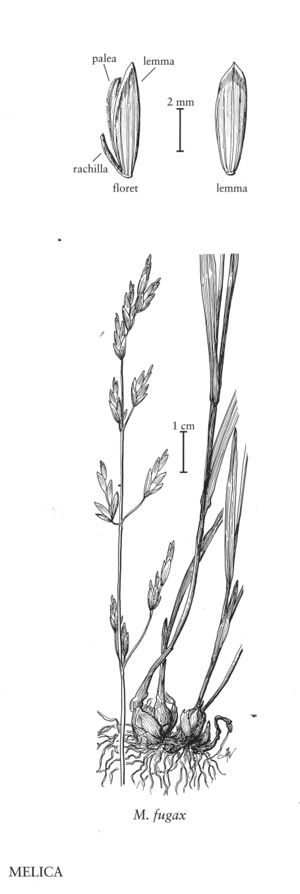Difference between revisions of "Melica fugax"
FNA>Volume Importer |
imported>Volume Importer |
||
| (8 intermediate revisions by 2 users not shown) | |||
| Line 4: | Line 4: | ||
|publications= | |publications= | ||
|common_names=Little melic | |common_names=Little melic | ||
| + | |special_status={{Treatment/ID/Special_status | ||
| + | |code=E | ||
| + | |label=Endemic | ||
| + | }} | ||
|basionyms= | |basionyms= | ||
|synonyms= | |synonyms= | ||
| Line 17: | Line 21: | ||
-->{{Treatment/Body | -->{{Treatment/Body | ||
|distribution=Calif.;Wash.;Idaho;Nev.;Oreg. | |distribution=Calif.;Wash.;Idaho;Nev.;Oreg. | ||
| − | |discussion=<p>Melica fugax grows at elevations to 2200 m on dry, open flats, hillsides, and woods, from British Columbia to California and east to Idaho and Nevada. It is usually found on soils of volcanic origin, and rarely below 1300 m. Melica fugax is often confused with M. bulbosa, but its rachilla internodes are unmistakable and unique among the species in the Flora region, being swollen when fresh and wrinkled when dry. One specimen, C.L. Hitchcock 15521 [WTU 114265] from Elmore County, Idaho, appears to be a hybrid. It has shrunken caryopses and combines the rachilla of M. fugax with the lemma pubescence, size, and overall appearance of M. subulata, but lacks corms.</p> | + | |discussion=<p><i>Melica fugax</i> grows at elevations to 2200 m on dry, open flats, hillsides, and woods, from British Columbia to California and east to Idaho and <i>Nevada</i>. It is usually found on soils of volcanic origin, and rarely below 1300 m. <i>Melica fugax</i> is often confused with <i>M. bulbosa</i>, but its rachilla internodes are unmistakable and unique among the species in the Flora region, being swollen when fresh and wrinkled when dry. One specimen, C.L. Hitchcock 15521 [WTU 114265] from Elmore County, Idaho, appears to be a hybrid. It has shrunken caryopses and combines the rachilla of <i>M. fugax</i> with the lemma pubescence, size, and overall appearance of <i>M. subulata</i>, but lacks corms.</p> |
|tables= | |tables= | ||
|references= | |references= | ||
| Line 26: | Line 30: | ||
-->{{#Taxon: | -->{{#Taxon: | ||
name=Melica fugax | name=Melica fugax | ||
| − | |||
|authority=Bol. | |authority=Bol. | ||
|rank=species | |rank=species | ||
| Line 33: | Line 36: | ||
|basionyms= | |basionyms= | ||
|family=Poaceae | |family=Poaceae | ||
| + | |illustrator=Linda Ann Vorobik | ||
| + | |illustration copyright=Utah State University | ||
|distribution=Calif.;Wash.;Idaho;Nev.;Oreg. | |distribution=Calif.;Wash.;Idaho;Nev.;Oreg. | ||
|reference=None | |reference=None | ||
|publication title= | |publication title= | ||
|publication year= | |publication year= | ||
| − | |special status= | + | |special status=Endemic |
| − | |source xml=https:// | + | |source xml=https://bitbucket.org/aafc-mbb/fna-data-curation/src/200273ad09963decb8fc72550212de541d86569d/coarse_grained_fna_xml/V24/V24_119.xml |
|subfamily=Poaceae subfam. Pooideae | |subfamily=Poaceae subfam. Pooideae | ||
|tribe=Poaceae tribe Meliceae | |tribe=Poaceae tribe Meliceae | ||
Latest revision as of 16:22, 11 May 2021
Plants cespitose, not rhizomatous. Culms 10-60 cm, forming corms; internodes smooth or scabridulous. Sheaths scabridulous to scabrous; ligules 0.5-2.6 mm; blades 1.2-5 mm wide, sometimes pilose on both surfaces. Panicles 4.5-18 cm; branches 0.8-4 cm, appressed to ascending, with 1-5 spikelets; pedicels straight. Spikelets 4-17 mm, with 2-5 bisexual florets; rachilla internodes 2.1-2.3 mm, swollen when fresh, wrinkled when dry; disarticulation above the glumes. Lower glumes 3-5 mm long, 1.5-2.5 mm wide, 1-3-veined; upper glumes 3.5-7 mm long, 2.5-3.5 mm wide, 5-veined; lemmas 4-7 mm, glabrous or scabrous, 4-11-veined, veins inconspicuous, apices rounded to acute, unawned; paleas almost as long as the lemmas; anthers 3, 1-2 mm; rudiments 1.5-3.5 mm, tapering, resembling the bisexual florets. 2n =18.
Distribution
Calif., Wash., Idaho, Nev., Oreg.
Discussion
Melica fugax grows at elevations to 2200 m on dry, open flats, hillsides, and woods, from British Columbia to California and east to Idaho and Nevada. It is usually found on soils of volcanic origin, and rarely below 1300 m. Melica fugax is often confused with M. bulbosa, but its rachilla internodes are unmistakable and unique among the species in the Flora region, being swollen when fresh and wrinkled when dry. One specimen, C.L. Hitchcock 15521 [WTU 114265] from Elmore County, Idaho, appears to be a hybrid. It has shrunken caryopses and combines the rachilla of M. fugax with the lemma pubescence, size, and overall appearance of M. subulata, but lacks corms.
Selected References
None.
